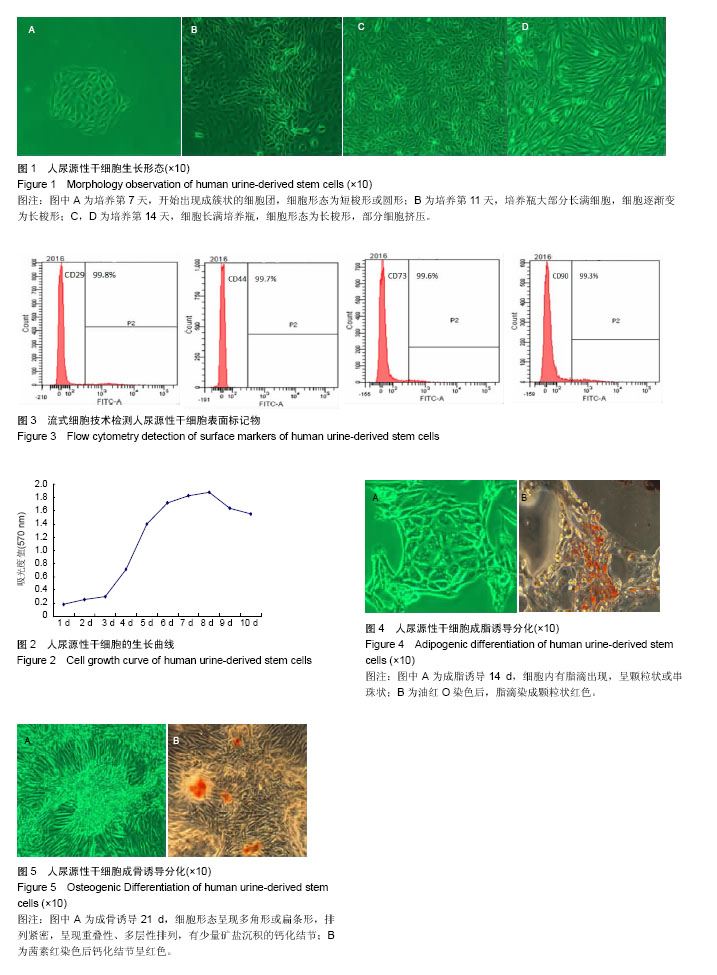| [1] Haasters F, Docheva D, Gassner C, et al. Mesenchymal stem cells from osteoporotic patients reveal reduced migration and invasion upon stimulation with BMP-2 or BMP-7. Biochem Biophys Res Commun. 2014;452(1):118-123.[2] Tan J, Wu W, Xu X, et al. Induction therapy with autologous mesenchymal stem cells in living-related kidney transplants: a randomized controlled trial. JAMA. 2012;307(11): 1169-1177.[3] Chen W, Xie M, Yang B, et al. Skeletal myogenic differentiation of human urine-derived cells as a potential source for skeletal muscle regeneration. J Tissue Eng Regen Med. 2017;11(2):334-341.[4] Wu S, Liu Y, Bharadwaj S, et al. Human urine-derived stem cells seeded in a modified 3D porous small intestinal submucosa scaffold for urethral tissue engineering. Biomaterials. 2011;32(5):1317-1326.[5] Bodin A, Bharadwaj S, Wu S, et al. Tissue-engineered conduit using urine-derived stem cells seeded bacterial cellulose polymer in urinary reconstruction and diversion. Biomaterials. 2010;31(34):8889-8901.[6] Zhang Y, McNeill E, Tian H, et al. Urine derived cells are a potential source for urological tissue reconstruction. J Urol. 2008;180(5):2226-2233.[7] 张秉鸿,符伟军,张旭,等. 生物可降解尿道支架种植尿道移行上皮细胞的研究[J]. 中华实验外科杂志, 2008, 25(4):543.[8] Caplan AI. Tissue engineering designs for the future: new logics, old molecules. Tissue Eng. 2000;6(1):1-8.[9] 周君梅,王雪,张胜利,等.隐睾和尿道下裂患儿尿源性细胞的培养和鉴定[J].中华小儿外杂志,2012,33(3):188-192.[10] Dominici M, Le Blanc K, Mueller I, et al. Minimal criteria for defining multipotent mesenchymal stromal cells. The International Society for Cellular Therapy position statement. Cytotherapy. 2006;8(4):315-317.[11] Guan JJ, Niu X, Gong FX, et al. Biological characteristics of human-urine-derived stem cells: potential for cell-based therapy in neurology. Tissue Eng Part A. 2014;20(13-14):1794-1806.[12] Zhang Y, Lin HK, Frimberger D, et al. Growth of bone marrow stromal cells on small intestinal submucosa: an alternative cell source for tissue engineered bladder. BJU Int. 2005;96(7): 1120-1125.[13] Jung KH, Song SU, Yi T, et al. Human bone marrow-derived clonal mesenchymal stem cells inhibit inflammation and reduce acute pancreatitis in rats. Gastroenterology. 2011; 140(3):998-1008.[14] Pittenger MF, Mackay AM, Beck SC, et al. Multilineage potential of adult human mesenchymal stem cells. Science. 1999;284(5411):143-147.[15] 李虹, 罗德毅. 尿道修复重建进展[J].现代泌尿外科杂志, 2012, 17(1):6-9.[16] 裴雪涛,刘大庆.干细胞应用中的伦理学问题[J].中华医学杂志, 2005, 85(27):1876-1877.[17] Purba TS,Haslam IS,Enrique P,et al. Human epithelial hair follicle stem cells and their progeny:current state of knowledge,the widening gap in translational research and future challenges.Bioessays.2014;36(5):513.[18] 武晓华,陈乃耀.人脐血间充质干细胞向多巴胺能神经元分化的体外诱导[J].中国组织工程研究,2012, 16(49):9186-9191.[19] 张剑平,路君,佟智超,等.尿源性干细胞的研究进展[J].中华医学杂志,2015, 95(48):3956-3958.[20] 朱文根,贺文凤,洪葵.干细胞的一种新来源--尿液[J].中华心血管病杂志,2014, 42(7):616-618. [21] Roth CC, Kropp BP. Recent advances in urologic tissue engineering. Curr Urol Rep. 2009;10(2):119-125.[22] Wu S, Wang Z, Bharadwaj S, et al. Implantation of autologous urine derived stem cells expressing vascular endothelial growth factor for potential use in genitourinary reconstruction. J Urol. 2011;186(2):640-647.[23] Bharadwaj S, Liu G, Shi Y, et al. Characterization of urine-derived stem cells obtained from upper urinary tract for use in cell-based urological tissue engineering. Tissue Eng Part A. 2011;17(15-16):2123-2132.[24] Bharadwaj S, Wu S, Rohozinski J, et al. 150 Multipotent stem cells from urine for tissue engineered bladder. J Urol. 2010; 183(4):e61.[25] Tabar V, Studer L. Pluripotent stem cells in regenerative medicine: challenges and recent progress. Nat Rev Genet. 2014;15(2):82-92.[26] Lang R, Liu G, Shi Y, et al. Self-renewal and differentiation capacity of urine-derived stem cells after urine preservation for 24 hours. PLoS One. 2013;8(1):e53980.[27] El-Kassaby AW, Retik AB, Yoo JJ, et al. Urethral stricture repair with an off-the-shelf collagen matrix. J Urol. 2003; 169(1):170-173.[28] 关俊杰.基于人尿源干细胞的骨组织工程研究[D]. 上海:上海交通大学,2015.[29] Zhou T, Benda C, Duzinger S, et al. Generation of induced pluripotent stem cells from urine.J Am Soc Nephrol. 2011; 22(7):1221-1228.[30] 赵雅培,刘翠景,杨翠英,等. 人尿源干细胞移植治疗慢性肾病大鼠[J]. 中国组织工程研究, 2016, 20(32):4838-4844. [31] Zhou T, Benda C, Dunzinger S, et al. Generation of human induced pluripotent stem cells from urine samples. Nat Protoc. 2012;7(12):2080-2089.[32] Zhou J, Wang X, Zhang S, et al. Generation and characterization of human cryptorchid-specific induced pluripotent stem cells from urine. Stem Cells Dev. 2013;22(5): 717-725.[33] Roehl AC, Mussotter T, Cooper DN, et al. Tissue-specific differences in the proportion of mosaic large NF1 deletions are suggestive of a selective growth advantage of hematopoietic del(+/-) stem cells. Hum Mutat. 2012;33(3): 541-550.[34] Atala A, Bauer SB, Soker S, et al. Tissue-engineered autologous bladders for patients needing cystoplasty. Lancet. 2006;367(9518):1241-1246.[35] Albertine KH, Dezawa M. A new age of regenerative medicine: fusion of tissue engineering and stem cell research. Anat Rec (Hoboken). 2014;297(1):1-3.[36] Raya-Rivera A, Esquiliano DR, Yoo JJ, et al. Tissue-engineered autologous urethras for patients who need reconstruction: an observational study. Lancet. 2011; 377(9772):1175-1182.[37] Brack AS, Rando TA.Tissue-specific stem cells: lessons from the skeletal muscle satellite cell. Cell Stem Cell. 2012;10(5): 504-514.[38] Faulk DM, Johnson SA, Zhang L, et al. Role of the extracellular matrix in whole organ engineering. J Cell Physiol. 2014;229(8):984-989.[39] Shimomura K, Moriguchi Y, Murawski CD, et al. Osteochondral tissue engineering with biphasic scaffold: current strategies and techniques. Tissue Eng Part B Rev. 2014;20(5):468-476.[40] 陈波特.兔尿源性干细胞的分离培养、鉴定及其生物学特性的研究[D]. 广州:广州中医药大学,2015.[41] Zhang D, Wei G, Li P, et al. Urine-derived stem cells: A novel and versatile progenitor source for cell-based therapy and regenerative medicine. Genes & Diseases. 2014; 1(1):8-17.[42] Cai J,Zhang Y,Liu P,et al.Generation of tooth-like structures from integration-free human urine induced pluripotent stem cells.Cell Regen. 2013;2(1):6.[43] 弓慧敏,白瑞,贾宗菲,等.两种培养基对羊驼毛囊干细胞生长和增殖的影响[J]. 山西医科大学学报, 2016, 47(5):424-428.[44] 白勇,武阳,凯赛尔•阿吉,等.脂肪干细胞与不同脱细胞基质的组织相容性研究[J].中国现代医学杂志,2017,27(4):7-12.[45] Chun SY,Kim HT,Lee JS,et al.Characterization of urine-derived cells from upper urinary tract in patients with bladder cancer. Urology. 2012;79(5):1186.e1.[46] 龚飞翔.人尿源性干细胞的分离培养及向神经细胞定向分化的体内外实验研究[D]. 南昌:南昌大学,2013. |
.jpg)

.jpg)